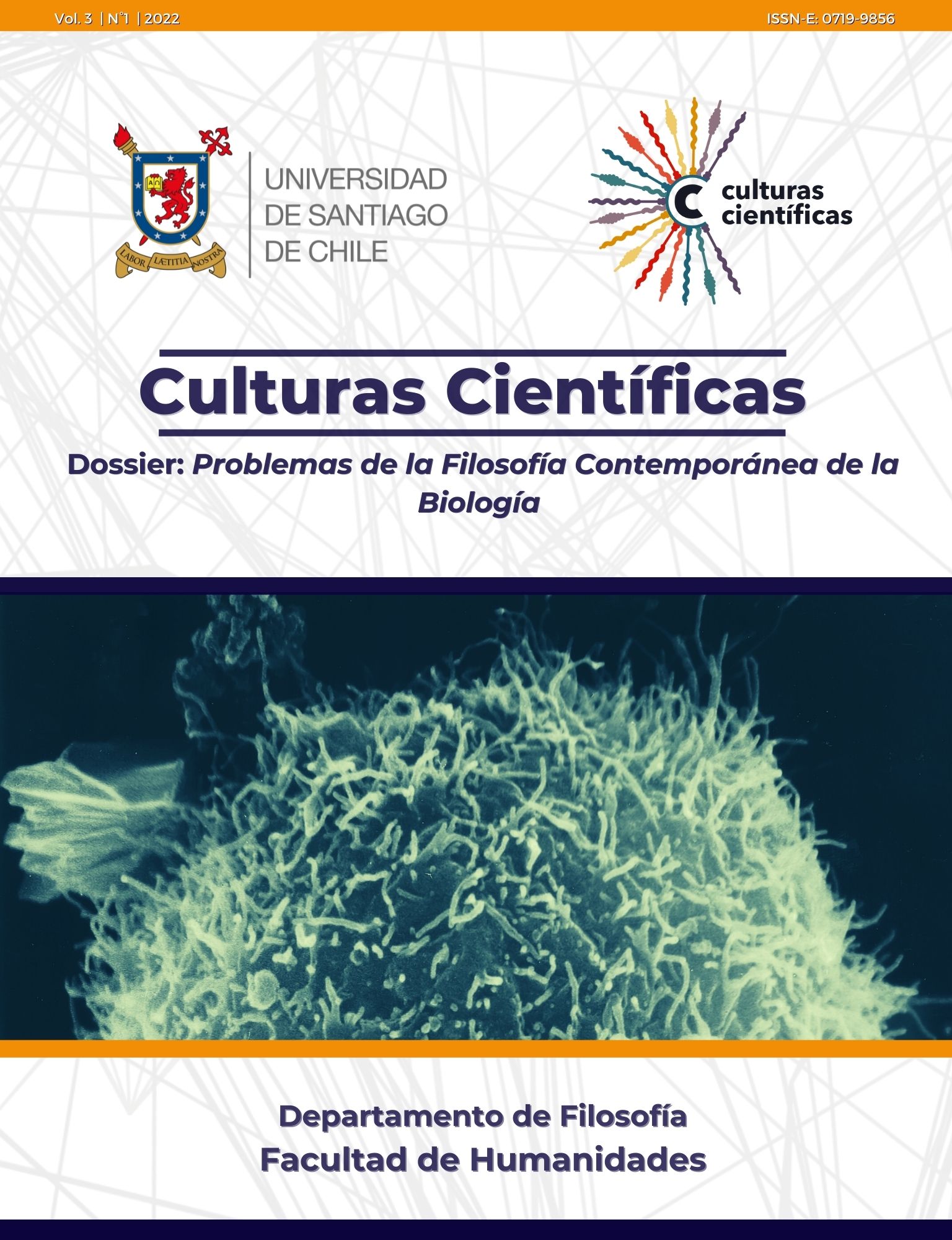¿La transferencia genética horizontal, la simbiogénesis, la especiación por hibridación y la introgresión traen realmente dificultades para la concepción cladogenética de la evolución?
DOI:
https://doi.org/10.35588/cc.v3i1.5385Palabras clave:
Filogenésis, Especiación por hibridación, Introgresión, Simbiogénesis, TGHResumen
En los últimos años, algunos autores han venido sosteniendo que la validez de la representación arborescente del patrón filético generado por la evolución está siendo menoscabada por el reconocimiento del impacto evolutivo que tendrían la transferencia genética horizontal (TGH), la simbiogénesis, la especiación por hibridación y la introgresión. Esa concepción o representación cladogenética de la evolución sólo nos dejaría ver un aspecto parcial de las relaciones de filiación que conectan a los diferentes linajes de seres vivos; ocultando otro aspecto cuya representación más adecuada sería un reticulado de relaciones entre taxones. Con todo, aún sin poner en tela de juicio la frecuencia y la relevancia explicativa de dichos fenómenos, en este trabajo se intentará mostrar que su admisión y reconocimiento no tiene por qué ir en detrimento de esa concepción cladogenética de la evolución cuya relativización se está pregonando. Por el contrario, la comprensión y la representación de tales fenómenos supone dicha concepción.
Descargas
Referencias
Abbott, R. y Rieseberg, L. (2012). “Hybrid Speciation”. Encyclopaedia of Life Sciences (eLS). Chichester: John Wiley & son. https://doi.org/h3hw
Abbott, R., Albach, D., Ansell, S., Arntzen, J., Baird, J., Bierne, N., Boughman, J., Brelsford, A, Buerkle, C., Buggs, R., Butlin, R., Dieckmann, D., Eroukhmanoff, F., Grill, A., Cahan, S., Hermansen, J., Hewitt, G., Hudson, A., Jiggins, C., … y Zinner, D. (2013). “Hybridization and speciation”. Journal of Evolutionary Biology, 26: 229–246. https://doi.org/f24mbz
Abbya, S., Tanniera, E., Gouya, M. y Daubina, V. (2012). “Lateral gene transfer as a support for the tree of life”. PNAS, 109 (13): 4962-4967. https://doi.org/h3hm
Abercrombie, M.; Hickman, C.; Johnson, M. (1957). Dictionary of Biology. Baltimore: Penguin.
Amorim, D. (1997). Elementos básicos de Sistemática Filogenética. Ribeirão Preto: Holos.
Andersson, J. (2005). “Lateral gene transfer in eukaryotes”. Cellular and Molecular Life Sciences, 62: 1182–1197. https://doi.org/c749n4
Avni, E. y Snir, S (2020). “A New Phylogenomic Approach For Quantifying Horizontal Gene Transfer Trends in Prokaryotes”. Scientific Reports, 10:12425. https://doi.org/h3hr
Bapteste, E., O'malley, M., Beiko, R., Ereshefsky, M., Gogarten, P., Franklin-Hall, L., Lapointe, F., Dupré, J., Dagan, T., Boucher, Y. y Martin, W. (2009). “Prokaryotic evolution and the tree of life are two different things”. Biology Direct, 4:34. https://doi.org/b5jpn8
Beiko, R. (2010). “Gene sharing and genome evolution: networks in trees and trees in network”. Biology & Philosophy, 25: 659-673. https://doi.org/ct2rjf
Bouchard, F. (2010). “Symbiosis, lateral function transfer and the (many) sampling of life”. Biology & Philosophy, 25: 623-641. https://doi.org/ddj35r
Bowler, P. (1996). Life’s splendid drama. Chicago: Chicago University Press.
Caponi, G. (2011). La segunda agenda darwiniana. México: Centro Lombardo Toledano.
Caponi, G. (2017). El darwinismo de Ameghino. Florianópolis: Universidade Federal de Santa Catarina.
Caponi, G. (2020a). “Los conceptos de herencia y de variación hereditaria”. Endoxa, 46:273-290. https://doi.org/h3ht
Caponi, G. (2020b). “El concepto evolucionario de linaje”. Revista Colombiana de Filosofía de las Ciencias, 20(41): 11-39. https://doi.org/h3nj
Cavalli-Sforza, L. y Cavalli-Sforza, F. (1994). Qui sommes-nous? Paris: Flammarion.
Coyne, J. y Orr, A. (2004). Speciation. Sunderland: Sinauer.
Crick, F. (1958). “On protein synthesis”. Symposia of the Society for Experimental Biology, 12: 138-63.
Darwin, C. (1859). On the origin of species. London: Murray.
Deleuze, G. y Guattari, F. (1980). Mille plateaux. Paris: Minuit.
Doolittle, W. (1999a). “Phylogenetic classification and the universal tree”. Science, 284 (5423): 2124-2128. https://doi.org/fjvz76
Doolittle, W. (1999b). “Lateral genomics”. Trends in Biochemical Sciences, 24(12): M5-M8. https://doi.org/d9s6mp
Doolittle, W. (2000). “Uprooting the tree of life”. Scientific American, 282(2): 90-95. https://doi.org/fhq7jr
Doolittle, W. (2005). “If the tree of life fell, would it make a sound?”. En J. Sapp (ed.). Microbial phylogeny and evolution: Concepts and controversies (pp. 119-133). Oxford: Oxford University Press.
Doolittle, W. (2010). “The attempt of the life of the tree of life: science, philosophy and politics”. Biology & Philosophy, 25: 455-473. https://doi.org/bfpr85
Doolittle, W. y Brunet, T. (2016): “What is the tree of life?” PLOS Genetics, 12(4): e1005912. https://doi.org/gnw9nr
Doolittle, W., Boucher, Y., Douady, C., Papke, T., Walsh, D., Boudreau, M., Nesbø, C. y Case, R (2003). “Lateral gene transfer and the origins of prokaryotic groups”. Annual Review of Genetics, 37: 283-328. https://doi.org/fk8bm2
Doolittle, W., Gogarten, P. y Lawrence, J. (2002). “Prokaryotic Evolution in Light of Gene Transfer”. Molecular Biology & Evolution, 19(12): 2226–2238. https://doi.org/fx74pj
Dunning, J., Clark, M., Oliveira, D., Foster, J., Fischer, P., Muñoz, M., Giebel, J., Kumar, N., Ishmael, N., Wang, S., Ingram, J., Nene, R., Shepard, J., Tomkins, J., Richards, S., Spiro, D., Ghedin, E., Slatko, B., Tettelin, H. y Werren, J. (2007). “Widespread Lateral Gene Transfer from Intracellular Bacteria to Multicellular Eukaryotes”. Science, 317(5845): 1753-1755. https://doi.org/brx7s8
Eldredge, N. y Cracraft, J. (1980). Phylogenetic patterns and the evolutionary process. New York: Columbia University Press.
Franklin-Hall, L. (2010). “Trashing life’s tree”. Biology & Philosophy, 25: 689-709. https://doi.org/c822gv
Futuyma, D. (2010). “Evolutionary Biology: 150 years of progress”. En M. Bel, D. Futuyma, W. Eanes y J. Levinton (eds.). Evolution since Darwin: the first 150 years (pp. 3-30). Sunderland: Sinauer.
Gayon, J. (2011). “The tree of life reconsidered”. En J. Martínez-Contreras y A. Ponce de León (eds.), Darwin’s evolving legacy (pp. 48-65). México: Siglo XXI.
Godfrey-Smith, P. (2009). Darwinian population and natural selection. Oxford: Oxford University Press.
Godfrey-Smith, P. (2014). Philosophy of Biology. Princeton: Princeton University Press.
Graham, L. y Davies, P. (2021). “Horizontal Gene Transfer in Vertebrates: A Fishy Tale”. Trends in Genetics, 37(6): 501-503. https://doi.org/gk7shq
Grant, P. y Grant, R. (2008). How and why species multiply: the radiation of Darwin’s finches. Princeton: Princeton University Press. https://doi.org/h3hz
Heams, T. (2009). “Hérédité”. En T. Heams, P. Huneman, G. Lecointre, M. Silberstein (eds.): Les mondes darwiniens (pp. 71-92). Paris: Editions Matériologiques.
Hennig, W. (1968). Elementos de Sistemática Filogenética. Buenos Aires: Eudeba.
Hillis, D. (2010). “Phylogenetic progress and applications of the tree of life”. En M. Bel, D. Futuyma, W. Eanes y J. Levinton (eds.). Evolution since Darwin: the first 150 years (pp. 421-450). Sunderland: Sinauer.
Holland, P. (2005). “The fall and rise of Evolutionary Developmental Biology”. En D. Williams y P. Forey (eds.), Milestones in Systematics (pp. 261-265). London: CRC Press.
Keeling, P.; y Palmer, J. (2008). “Horizontal gene transfer in eukaryotic evolution”. Nature Reviews Genetics, 9: 604-618. https://doi.org/fqbv8j
Kitcher, P. (2001). El avance de la ciencia. México: UNAM.
Koonin, E. (2009). Darwinian evolution in the light of genomics. Nucleic Acids Research, 37(4): 1011-1034. https://doi.org/fjhq8g
Le Guyader, H. (2003). Classification et évolution. Paris: Le Pommier.
Ledford, H. (25 de marzo de 2021). First known gene transfer from plant to insect identified. Nature News. https://doi.org/h3h2
Mamalipour, M., Seidi, K., Zununi, S., Jahanban-Esfahlan, V., Jaymand, M., Majdi, H., Amoozgar, Z., Javaheri, T., Jahanban-Esfahlan, R. y Peyman, Z. (2020): “Horizontal Gene Transfer: from evolutionary flexibility to disease progression. Frontiers in Cell and Developmental Biology, 8:229. https://doi.org/h3h4
Margulis, L. (1992). “Symbiosis theory: cells as microbial communities”. En L. Margulis y L. Olendzenski (eds.): Environmental evolution (pp. 173-200). Cambridge: MIT Press.
Margulis, L. y Sagan, D. (1995). Microcosmos. Tusquets, Barcelona.
Martin, W. (2005). “The missing link between hydrogenosomes and mitochondria”. Trends in Microbiology, 13(10): 457-459. https://doi.org/dkdrgc
Mayr, E. (1992). Una larga controversia: Darwin y el darwinismo. Barcelona: Crítica.
Merlin, F. (2017). “Limited extended inheritance”. En P. Huneman y D. Walsh (eds.), Challenges in Evolutionary Theory (pp. 285-301). Oxford: Oxford University Press.
Meyer, D. (1997). “Análise filogenética de sequências de DNA”. En D. Amorim (ed.). Elementos básicos de Sistemática Filogenética (pp. 187-210). Ribeirão Preto: Holos.
Mindell, D. (2013). “The tree of life: metaphor, model, and heuristic device”. Systematic Biology, 62(3): 479-489. https://doi.org/ggbq25
O’Malley, M. y Boucher, Y. (2005). “Paradigm change in evolutionary microbiology”. Studies in History and Philosophy of Biological and Biomedical Sciences, 36: 183-208. https://doi.org/fr6sn6
O’Malley, M., Martin, W. y Dupré, J. (2010). The tree of life: introduction to an evolutionary debate. Biology & Philosophy, 25: 441-453. https://doi.org/dmxh3q
Ochman, H., Lawrence, J. y Groisman, E. (2000). “Lateral gene transfer and the nature of bacterial innovation”. Nature, 405: 299-304. https://doi.org/bnspkk
Ospovat, D. (1981). The development of Darwin’s theory. Cambridge: Cambridge University Press.
Panchen, A. (1992). Classification, evolution and the nature of Biology. Cambridge: Cambridge University Press. https://doi.org/ffjpp2
Power, J., Pinheiro, F., Pompei, S., Kovacova, V., Yüksel, I., Rathmann, M., Förster, Mona, Lässig, M. y Maier, B. (2021). “Adaptive evolution of hybrid bacteria by horizontal gene transfer”. PNAS, 118 (10): e2007873118. https://doi.org/gns4c9 .
Raoult, D. (2010). The post-Darwinist rhizome of life. The Lancet, 375: 104-105. https://doi.org/crfndh
Richards, R. (2016). Biological Classification. Cambridge: Cambridge University Press.
Russell, E. (1916). Form and function. London: Murray.
Salgado, L. y Arcucci, A. (2016). Teorías de la evolución. Viedma: Universidad Nacional de Rio Negro.
Schwartz, R. y Dayhoff, M. (1978). “Origins of prokaryotes, eukaryotes, mitochondria and chloroplasts”. Science, 199 (4327): 395-403. https://doi.org/b4vqcj
Sober, E. (2008). Evidence and evolution. Cambridge: Cambridge University Press. https://doi.org/h35x
Suarez, E. (2007). “The rhetoric of informational molecules: authority and promises in the early study of molecular evolution”. Science in Context, 20(4): 649-677. https://doi.org/bszxpz
Suárez, E. y Anaya, V. (2008). “History, objectivity, and the construction of molecular phylogenies”. Studies in the History and Philosophy of Biological & Biomedical Sciences, 39(4): 451-468. https://doi.org/fhd7gw
Swithers, K. y Katz, L. (2013). “Reconstructing the Tree of Life”. Microbe, 8(6): 249-253. https://doi.org/h35z
Tassy, P. (1998). L’arbre à remonter le temps. Paris: Diderot.
Tassy, P. (2000). Le paléontologue et l’évolution. Paris: Le Pommier.
Torres, S. y Prosdocimi, F. (2019). A emergência dos sistemas biológicos. Rio de Janeiro: Artecomciência.
Waters, K. (2003). “The arguments in the Origin of Species”. En J. Hodge y G. Radick (eds.): The Cambridge companion to Darwin (pp. 116-137.). Cambridge: Cambridge University Press.
Wiley, E. & Lieberman, B. (2011). Phylogenetics. Hoboken: Wiley-Blackwell. https://doi.org/bhhwhj
Zuckerkandl, E. y Pauling, L. (1965). Evolutionary divergence and convergence in proteins. En V. Brysona y H. Vogel (eds.). Evolving genes and proteins (pp. 97-166). Cambridge: Academic Press. https://doi.org/gf4ft7
Descargas
Enviado
2022-01-25Publicado
Número
Sección
Licencia
Derechos de autor 2022 Gustavo Caponi

Esta obra está bajo una licencia internacional Creative Commons Atribución 4.0.











